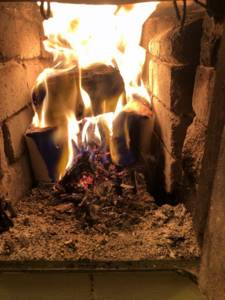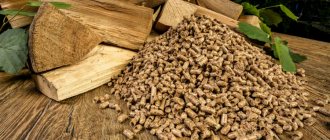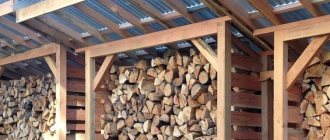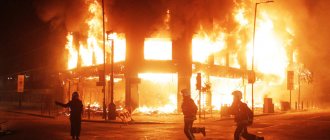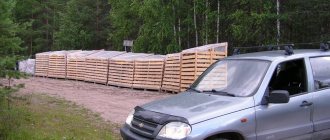Removal, processing and disposal of waste from hazard classes 1 to 5
We work with all regions of Russia. Valid license. A complete set of closing documents. Individual approach to the client and flexible pricing policy.
Using this form, you can submit a request for services, request a commercial offer, or receive a free consultation from our specialists.
Many houses still have stoves. As fuel, you can purchase regular firewood or a more modern option - pressed briquettes. The purpose of the invention of fuel bars is to recycle inexpensive waste and at the same time obtain a means of creating efficient heating of buildings.
Advantages and disadvantages
To understand how good fuel briquettes are, you should consider their positive and negative sides.
The advantages are as follows:
- Since Euro firewood has the correct shape, it is very convenient to store it.
- Fuel briquettes have a much higher calorific value than firewood. This results in savings on raw materials.
- Suitable for any stoves and gas boilers. Due to the long burning of compressed sawdust, adding new portions of raw materials occurs much less frequently.
- The combustion is uniform and silent, small coals do not fly around. When using raw materials, the emission of smoke and the formation of resins and ash is insignificant. This leads to a reduction in labor costs for cleaning and cleaning chimneys.
- Depending on the method of production of Euro firewood, their shelf life ranges from one to 5 years.
- The bars do not contain chemicals, therefore they are considered an environmentally friendly product.
- During one heating season, 1.5-2 times less briquette fuel is used compared to conventional firewood.
- Eurobriquettes burn slowly and gently. This generates a lot of heat.
In addition to the positive qualities, compressed products have some disadvantages:
- During storage, avoid exposure to water.
- Some types are stored for no more than one year.
- The cost of raw materials is quite high.
Today, the productivity and demand for briquetted fuel is growing. The price of European firewood is high, but you can save money thanks to their properties.
Advantages of briquettes
Fuel briquettes have a lot of advantages. Reviews from consumers and experts make it clear that in addition to being environmentally friendly, Euro firewood has a high calorific value. It is 2 times higher than that of ordinary wood. There are several explanations for this.
Wood moisture content is about 15%. When producing briquettes, the material is heavily dried. The result is a product made from the same wood, for example, but with a moisture content of 4 to 8%. It is this factor that causes the combustion temperature of the material to increase.
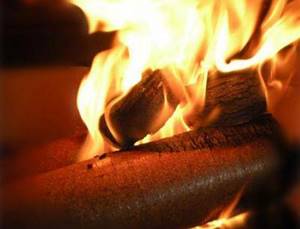
The second important reason why a similar effect is observed is the high density of Euro-firewood. It is 0.9-1.3 g/cm3
Ordinary wood has a density of 0.4-0.8 g/cm3. This means that the substance that undergoes combustion will be larger by the same volume. These reasons determine the high calorific value of Eurowood.
Briquette classification
Based on their shape and manufacturing technology, the bars are divided into several types.
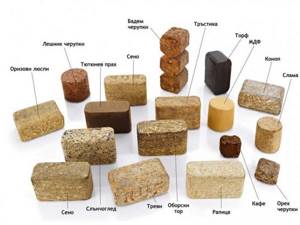
By shape
The most common types of fuel briquettes, differing in shape:
The fuel material is the same. The products have the same calorific value, but different densities.
Piney bars can be square or hexagonal. The hole along the central part creates ventilation, which promotes combustion. The density of Eurowood is the highest, equal to 1.08-1.40 g/cm3.
Roof briquettes are made in the form of small bricks. They have a low density - from 0.75 to 0.8 g/cm3.
Eurofirewood Nestro is shaped like cylinders. Their density is average - from 1 to 1.15 g/cm3.
By material
To make fuel, sawdust, husks of seeds, buckwheat and rice, tyrsa, and peat are used.
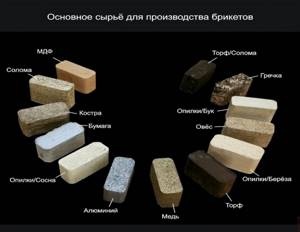
The material of briquette raw materials depends on:
- ash content
- combustion degree
- presence of soot
- calorie content
Based on the results of comparing the characteristics, it turned out that, despite the identical composition of the briquettes, their properties may differ.
Bars made from seeds have the highest calorific value. The presence of oil in their composition promotes combustion, which is an indicator of high energy value. However, the oil causes soot to accumulate in the chimney.
- Wood briquettes made from compressed sawdust have less calories.
- Straw bars are quite in demand, their calorie content is slightly lower and their ash content is higher.
- Eurofirewood from tyrsa has excellent heat transfer, while its ash content is high.
- Briquettes made from compressed rice husks, on the contrary, have high ash content and low calorific value.
DIY briquettes
Self-production allows you not only to heat the house, but also to save a lot and eliminate long-standing garbage.
Stages of self-production
Stage 1. Materials for production.
Several raw material options are perfect, for example:
- waste from wood processing;
- paper;
- straw;
- charcoal;
- different types of husk;
- peat.
As binding components can be used:
- clay;
- wallpaper glue or any other inexpensive one;
- paper;
- corrugated cardboard.
Stage 2. Preparation of raw materials. You will need the material itself, as well as additional components: water and clay.
Stage 3. Necessary tools and equipment.
There are enterprises that are engaged in the production and sale of equipment necessary for the production of Euro firewood. For an additional fee, they deliver directly to your home, install it, and also check its functionality. There are companies that teach how to properly operate the devices.
For home production you will need:
- Device for grinding material.
- Drying complex.
- Press. It can be screw, hydraulic or mechanical.
There is no need to use a drying unit, since they can be dried in the open air. If sawdust is used for production, then a grinding device is not required.
In addition, do not forget about a box with cells of the same shape. You can build it yourself from any box, dividing it into the required sectors using planks.
Stage 4. Production. Depending on the material used, we will consider several options for making Euro firewood.

Instructions for making from sawdust
- Step 1. Combine clay with sawdust in a ratio of 1:10. Clay calculation is 100 grams per 1 kg of raw materials. Add a little water and mix thoroughly until the clay covers the sawdust as much as possible. The consistency should be easy to form. To improve the combustion process, you can add well-shredded paper.
- Step 2. Distribute the resulting mixture into molds and compress well. The more liquid you can squeeze out, the better.
- Step 3. Leave the raw material under pressure for a while.
- Step 4. Remove the finished products from the mold and dry them in the firebox or in the sun.
- Step 5. Place the completely dried items in a storage location for future use.
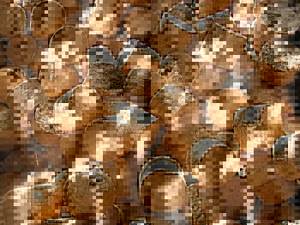
Paper making instructions
- Step 1. Prepare a large amount of paper and shred it into pieces measuring 2x2 cm.
- Step 2. Fill the paper with warm water and wait until it turns into liquid. Experts advise adding a small amount of starch to water
- Step 3. Eliminate excess water and pour the mixture into molds.
- Step 4. Remove the product from the mold and dry.
In addition to sawdust and paper, other materials are used to create briquettes, for example, pine needles or seed husks. They are not the best option, but are quite possible as an alternative. The disadvantage of needles is a labor-intensive process; large needles require chopping by hand using scissors.
The husks from the seeds are very attractive to mice, so it is likely that the prepared briquettes will be spoiled before the onset of winter.
Popular types of wood briquettes
The most common types of bars on sale are those made from wood.
Fuel briquettes ruf
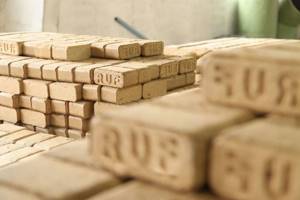
The shape of the fuel resembles bricks. The material used for RUF briquettes is birch dust or dried sawdust, for example, from alder or ash. First, the crushed sawdust is soaked in water, then a binder is added to the resulting mixture. Then the mass is poured into molds. Briquetting of sawdust occurs under high pressure. The raw materials can be used for any type of furnace. The inscription RUF is printed on the surface of the bars.
Fuel briquettes made from RUF sawdust emit more heat, they are convenient to store and load into chambers. The bars are not sensitive to moisture, but still water ingress is undesirable. Eurobriquettes are supplied by many manufacturers, for example, Prometheus.
Eurobriquettes pini kay
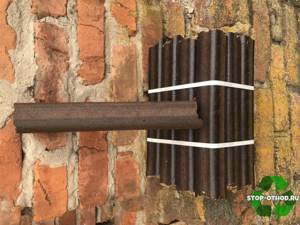
The shape of PINI KAY products resembles a pencil with the lead removed. The hole in increases traction. During production, briquettes are fired; this drying creates protection from excess moisture and increases their strength.
The disadvantage of PINI KAY Eurobriquettes is their high price, but they have the following positive qualities:
- burn well
- generate a lot of heat
- convenient to transport and store
Fuel briquettes are used for fireplaces. Sometimes eurowood is used to make a fire.
Simple cylindrical briquettes
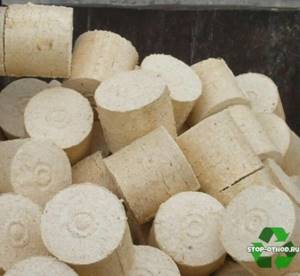
On sale you can find simple cylindrical fuel briquettes. For their production, pressed sawdust and small wood waste are used. The material is pressed under considerable force using an adhesive base. Fuel bars have a low cost. The downside is low strength, that is, they crumble and are susceptible to moisture.
How to choose a good peat briquette?
When buying raw materials, do not trust the seller’s word regarding thermal conductivity, humidity, and ash content. Ask him for the relevant documents, test reports, which will indicate the characteristics of a specific batch of goods.
The raw materials should be as dense as possible, that is, not crumble in your hands, this will indicate low quality. And, as a result, it will burn out quickly and give off less heat.
Well, lastly, before purchasing a supply for the season, we recommend purchasing a small trial batch. Try to see what quality it is and, if everything suits you, only then buy a large volume.
How to properly burn with briquettes
Sauna stove
Eurobriquettes are a universal tool suitable for lighting a steel stove in a bathhouse. What matters here is not only the amount of heat generated, but also the duration of fuel combustion.
After ignition, the pressed product smolders for approximately 2 hours. Regular firewood burns much faster. Eurobriquettes have a high density and low humidity, which explains their long combustion.
Based on observations, completely filling the firebox is undesirable. This will help to avoid quickly reaching maximum heat output.
Since the density of fuel briquettes is high, the product is almost completely burned, and the remaining ash can be used as fertilizer.
When using Eurobriquettes, smoke emission is minimal, which means you have to clean heating appliances less often. It is believed that linden fuel bars contain less resin, so chimneys are almost not polluted.
Stove for heating a house
Eurobriquettes are often used for heating houses. One ignition of the stove is enough to maintain the fire for a long time without adding fuel.
To light a brick oven, you must first light the bricks. To do this you will need tree bark, wood chips, and dry newspapers. Fuel should be placed on top of all this. At the moment of kindling, it is important that there is airflow. When the first part of the briquettes lights up, you can add the next batch.
Another method of kindling is to add fuel to the coals left over from the combustion of the first batch of firewood.
There are two ways to fill the stove with fuel briquettes:
- Place the bars loosely in relation to each other. This helps to quickly heat the house.
- Fold the raw materials tightly. This will cause the fuel to smolder, which is a suitable option for heating the house at night. The consumption of fuel briquettes in this case is much less compared to firewood.
Harvesting and storing firewood is more difficult when compared to storing eurobriquettes. The finished compressed raw materials are placed in separate packages, which are wrapped in cellophane. This prevents moisture from entering. Store fuel in utility rooms, basements, sheds or attics. The products are in the shape of tubes or bricks, so they are very convenient to store. Bars take up much less space than firewood.
Fire wood stoves
Wood-burning stoves provide efficient heating of residential and non-residential premises. They are presented in many models, differing in their technical characteristics and design. They use the most ordinary firewood as fuel - they can be purchased by the truckload. But this fuel cannot be called modern and efficient. And today it has been replaced by fuel briquettes for heating stoves.
To clarify, let's look at the main disadvantages of traditional wood fuel:
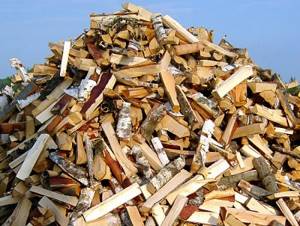
Ordinary firewood must first be chopped and then placed in neat woodpiles. This is a very labor-intensive and time-consuming process.
- It is inconvenient to stack firewood in neat stacks - if they are the same size and format, then this is not so bad. But if some logs are thin, while others are thick, and even knotty, then the masonry will be crooked and oblique (although a lot here depends on the “curvature” of the hands);
- Firewood needs to be split - it often comes in the form of round logs that require chopping. Swinging an ax in cold weather is a dubious pleasure (although useful);
- Firewood is often damp - seeking for their own profit, lumberjacks sell the wood in a raw state, without first drying it. Compared to almost dry fuel briquettes for heating stoves, they will not be easy to light;
- Low calorific value - a cubic meter of firewood produces less heat than the same wood briquettes of the same volume ;
- Firewood produces a large amount of ash - the same wood briquettes practically do not clog the stoves;
- Wood burns with clicking and crackling sounds, burns unevenly, clearly inferior to briquettes in this regard.
Recommendations for choosing fuel briquettes
In order for fuel products to burn well, when choosing, you should adhere to the following principles:
- It is best to use sawdust briquettes. The oil contained in the fuel raw material from seed husks contributes to the contamination of heating devices.
- Due to the resin in pine briquettes, chimneys become dirty.
- When purchasing fuel, you should first read the documents containing the product characteristics.
- It is recommended to choose Euro firewood with maximum density. The duration and uniformity of combustion depends on this.
- If a large amount of fuel is needed, it is better to start by purchasing 10-20 kg of raw materials for a sample from different places. Poor quality of a briquette can be determined by its appearance, for example, if it crumbles. Samples should be burned individually, checking the duration and efficiency of combustion. It is worth paying attention to the remaining coals, which may fall apart or hold their shape. Such experiments will help you choose high-quality fuel.
Advertisements for fuel briquettes claim that fuel briquettes have twice the heat output, burn four times (!) longer than regular birch firewood, leave less soot and take up less space.
As you can see in the picture above, the label of fuel briquettes promises very tempting characteristics of this high-tech type of fuel, produced from absolutely free raw materials - birch wood dust (not even sawdust). We purchased a package of fuel briquettes weighing 10 kg at retail for 129 rubles. A wholesale ton of fuel briquettes (a little more than a cubic meter - the density of fuel briquettes is 950 kg/m3) costs 6,000 rubles. In terms of a cube, this is 6,315 rubles, while a cube of birch firewood in bulk costs approximately 1,600 rubles (Leningrad region. For example, in the Pskov region, firewood can cost 1,000 rubles per cube in bulk).
What is the relationship between a cubic meter of bulk firewood, a cubic meter of stacked (stacked) firewood and a cubic meter of dense wood?
Let's say they brought you a cubic meter of firewood in bulk. How much is the actual volume of dense wood in this pile of firewood? For firewood approximately 30-35 cm long, the conversion factor from a bulk cube to a stacked cube is 0.75. That is, instead of a cube in bulk, you actually have 0.75 cubes of neatly stacked firewood.
To convert firewood from a cube to packing dense wood into a cube, a coefficient of 0.7 is used. That is, we multiply 0.75 cubic meters by 0.7 and get 0.52 cubic meters of dense wood.
So remember, if you buy firewood in bulk, then in terms of dense wood you are purchasing exactly half of the “cubic meter of firewood in bulk.” A cubic meter of fuel briquettes in a package approximately corresponds to a cubic meter of dense wood.
Now let’s compare the prices of firewood and fuel briquettes per cube of dense wood. A cubic meter of fuel briquettes per cubic meter of dense wood costs 6,000 rubles, and a cubic meter of bulk firewood per cubic meter of dense wood costs 1,600 / 0.5 = 3,200 rubles.
Thus, the difference in price between briquettes and firewood for the Leningrad region is 6000 / 3200 = 1.87 times. For the Pskov region, where firewood is cheaper, the difference will be 6000 / 2000 = 3 times.
When purchasing fuel briquettes at retail at a price of 7,000 rubles per cubic meter, the difference in price with birch firewood for the Leningrad region will be 7,000 / 3,200 = 2.18 times.
It should also be taken into account that in the mass of firewood from 12 (wood dried for several years), 20-25% (stale firewood) and up to 50% (wet firewood) is water, and in fuel briquettes the mass of water is no more than 8-9%
So, let's try to find out whether the two or three times difference in price (without taking into account the difference in humidity) is worth the convenience, manufacturability, increased heat transfer and increased burning time of fuel briquettes? Let's conduct an experiment with fuel briquettes, which does not pretend to be scientific, does not have statistical significance, but can lead consumers to certain thoughts.
| So, who will win: fuel briquettes versus birch firewood - is the triple price worth the money? | Let's roughly equalize the chances: we take equal mass volumes of birch firewood and fuel briquettes (approximately 2.2 kg). It should be noted that judging by the stated characteristics of 2.2 kg of fuel briquettes, the dry matter mass is greater than in birch firewood, since in firewood several times more water. |
| For kindling, place fuel briquettes on paper and birch bark in the fireplace. | We place firewood in exactly the same conditions: we melt it using paper and birch bark. Both firewood and fuel briquettes ignite equally well. |
| The combustion of fuel briquettes occurs clearly more slowly: layers of compressed dust burn, and until the top layer burns out, the inner ones do not light up. | A little secret from England: to prevent soot from depositing in the chimney, throw a pinch of salt on the firewood or fuel briquettes with each stack. |
| When burning fuel briquettes, the flame is small and ugly. If you need a decorative flame for your fireplace, then fuel briquettes are not for you. | Birch wood in the stove burns with a large, beautiful flame. |
| With a small flame of fuel briquettes, the heat generated is significantly less: I sit with the camera at a distance of a meter from the fireplace. Fuel briquettes burn much more vigorously if they are placed vertically. | When wood burns, so much heat is released that I shoot from two meters and use zoom - it’s impossible to sit in front of the fireplace at a distance of a meter. |
| The first hour has passed: the briquettes have not decreased much in volume and continue to burn. | By the end of the first hour I had already broken the wood into coals, but small tongues of flame were still dancing on them. The pure honest burning time of three birch logs weighing 2.2 kg is 1 hour. Advertising on the packaging of fuel briquettes claimed that the firewood burned out in 30 minutes. This turned out to be untrue. |
| It was necessary to break the briquettes into coals at about 90 minutes of burning. The full honest burning time of fuel briquettes is exactly 2 hours. The advertising of fuel briquettes fully corresponds to our results in terms of burning time: 120 minutes. | The birch wood embers burned out in the 80th minute. However, this time was not counted - the flame disappeared in the 60th minute. |
Briquettes for furnaces and boilers
As an alternative to firewood, fuel briquettes have a number of advantages:
- Wood burns longer and produces more heat;
- No sparks, much less smoke;
- Very economical, because you can make briquettes with your own hands from waste, that is, there will be virtually no costs;
- There is no need to throw away the ash; it will become an excellent fertilizer for garden beds;
- When stored, identical briquettes take up less space than a traditional firewood box;
- Can be used not only for fireplaces and stoves, but also for solid fuel boilers.
In general, as experts note, the production of fuel briquettes can become a profitable business.

To produce fuel briquettes, you can use a variety of materials, and the vast majority are waste that is found in every household:
- Waste paper. Newspapers, cardboard boxes, scribbled notebooks - everything that is lying idle at home;
- Agricultural waste. For example, straw, sunflower husks, dry plant stems;
- Waste from the garden and vegetable garden. Fallen leaves are also used, as are tops of root crops, dry grass, and pulled out weeds;
- Branches, shavings, wood chips, sawdust, that is, all wood waste, including that remaining after pruning trees on the site.
Important! Some owners add plastic bags and film to the plant and wood pulp. Experts are against this approach, because in this case briquettes can no longer be called environmentally friendly fuel. And you can’t use ash as fertilizer
In general, there are no official recommendations regarding the addition of polyethylene film to briquettes; everything is at the owner’s own risk.
And you can’t use ash as fertilizer. In general, there are no official recommendations regarding the addition of polyethylene film to briquettes; everything is at the owner’s own risk.

To get started, you will need to grind the raw materials, everything except sawdust, seed husks and small shavings. For this purpose, a garden shredder is used, the choice of which we have already written about. We thoroughly chop all branches, sticks, leaves, wood chips, dry grass, and straw to obtain prepared raw materials for fuel briquettes.
Important! An ordinary garden shredder will not cope with paper and waste paper. You will have to tear it by hand, cut it, use a shredder

Clay and starch, as well as wax, are most often used as binders in the mixture for fuel briquettes. Portland cement is sometimes added, but it greatly increases the ash content of the fuel. Sugar and molasses are also an option, but they are expensive. If it is possible to find waste from pulp and paper production, you can use sulfite-yeast mash. However, it contains too much moisture.
Important! If fuel briquettes are made from sawdust and other wood waste, then binders are not needed. They are lignin, a natural polymer initially contained in wood and released at high temperature and under pressure. But this rule applies if baking is used rather than natural drying.
But this rule applies if baking is used rather than natural drying.
In addition, binders are not needed if the mixture contains paper. It is softened by water, and in itself serves as a good glue that holds all the other components of the briquette.
If clay acts as a binder, then its proportion with waste should be 1:10, no more. Water is added little by little so that the whole mixture acquires the consistency of a paste, which will be easy to shape into the desired shape.
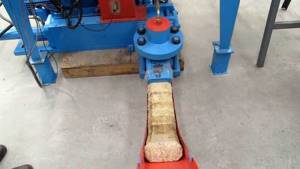
You can use a concrete mixer or a construction mixer to mix the mixture. This will speed up the process and make the mixture smooth. Next you need a mold for pressing. Sometimes summer residents even use old pots, wooden boxes, and other items that are no longer needed in everyday life.
The easiest way is to manually press the mixture into the chosen shape and then dry it in the sun, naturally. But manual efforts may not be enough to get a high-quality, non-scattering fuel briquette. Therefore, home craftsmen usually use various mechanized presses. If you have a vibrating table, then you don’t need a press.
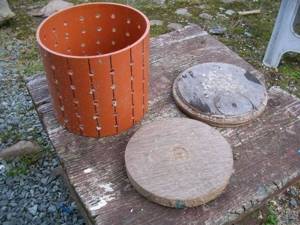
The process of creating a mixture for fuel briquettes and their pressing and molding is simple, but labor-intensive. That is why many people prefer to either buy ready-made briquettes or purchase special machines that significantly facilitate production. In addition, we admit that factory briquettes, which are formed under 20-ton presses, are much denser, and therefore will burn longer.
General information
Fuel briquettes, or Eurofirewood as they are also called, are made from pressed natural materials, most often sawdust, sometimes peat or straw, rarely from seeds or nut shells. During the pressing process, most of the moisture is removed from the wood, which makes it possible to obtain high calorific characteristics. Unlike firewood, whose maximum dryness is determined by 20% humidity, the same parameter for fuel briquettes is 8-9%.
The design of briquettes can be different:
- Eurobriquettes RUF - made exclusively by pressing without additional processing.
- Nestro Eurobriquettes are compressed logs that have a cylindrical shape, sometimes with a hole in the middle.
- Eurobriquettes Pini-Kay are compressed sawdust fired with a gas-air mixture to create a more durable shape, which increases storage time and protection from moisture.
Regardless of the type of fuel briquettes, their density is higher than wood, which allows them to burn well and release a large amount of heat. Thermal characteristics differ for Eurobriquettes made from different materials; usually high-quality types of wood, cereal seed husks, straw, and peat are used.
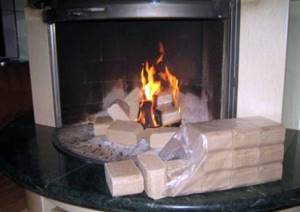
In the production of all types of eurobriquettes, no adhesive additives are used, since wood and similar materials contain a suitable lignin component that can glue all the sawdust together.
Due to the fact that fuel briquettes are made from drier wood, their calorific value is significantly greater than that of ordinary firewood or brown coal and is remotely comparable to the characteristics of black coal. For example, dry birch firewood emits 2500 kcal/kg when burned, brown coal about 3800 kcal/kg, and fuel briquettes 4500 kcal/kg. Thus, for heating premises, the option with such fuel is quite acceptable, but are fuel briquettes suitable for a bathhouse, is it possible to heat a stove in it using this fuel.
Biofuel for the fireplace
Biofuel is a type of fuel from biological raw materials, produced from waste products of organisms, from animal or plant raw materials, or as a result of processing biological waste.

Biofuel for fireplaces is the best type of fuel that does not require the presence of a chimney. Suitable for eco-fireplaces.
The prefix “bio” arose as a result of the use of renewable plant resources in production.
At its core, fireplace fuel is denatured ethanol made from regular ethanol.
Ethanol is an alcohol produced during the fermentation of plant sugar-containing crops (beets, potatoes, cane sugar, wheat).
You can also obtain pure alcohol by hydrolyzing raw materials with a high cellulose content (straw, wood).
According to international rules, free retail sale of pure alcohol is prohibited. Therefore, biofuel for fireplaces is produced by denaturing ethanol.
During the denaturation process, ethanol becomes environmentally neutral.

Biofuel for fireplaces does not have a harmful effect on the human body or other animal organisms.
The combustion of ethanol is accompanied by its decomposition with the formation of carbon monoxide, steam and some heat. During the combustion process, beautiful, even tongues of fire are formed.
Ecological fuel is absolutely safe, burns without soot, odor and smoke. Due to this, there is no need to install a smoke hood and heat is not lost, but is retained in full in the room.
Thus, the efficiency of biofuel is 95%. The appearance of the flame produced by burning biofuels is practically no different from the appearance of burning logs. The use of biotollive in the form of a gel containing sea salt allows you to enjoy the complete illusion of fire with the characteristic crackling of real firewood.

There are several types of such fuel, among which it is worth noting:
- biogas;
- biodiesel;
- bioethanol
To produce biodiesel, vegetable fats are used, as well as some animal products. Rapeseed, coconut, palm, soybean, etc. oils are usually used as a production resource.
Many plant and animal components are obtained from food industry waste. This product is usually used for transport work.

Bioethanol is considered as an environmentally friendly analogue of gasoline.
The product is obtained through the fermentation of carbohydrates, the source of which is raw materials with a high content of starch, sugar or cellulose. To produce biogas, waste of organic origin is literally used, which is decomposed by bacterial cultures.
Bioethanol, which looks like a colorless, odorless liquid, is created on the basis of alcohol. Alcohol for creating fuel is obtained from carbohydrates found in sugar, which is the key to the naturalness of the product. Sugar is extracted from cane, potatoes, beets, and corn. Ethanol can be produced from wood raw materials that contain cellulose.
Eco-fireplaces use denatured ethanol. It is formed as a result of the fermentation of wheat, cane sugar, beets, potatoes, etc.

Ethanol is also produced by hydrolyzing wood, straw and other high cellulose content resources.
The combustion process of such practically pure alcohol is not accompanied by the release of soot, smoke and other products.
Biogas fuel produced from human waste and considered an analogue of natural gas. Used mainly for industrial purposes.
Advantages of biofuels:
- Environmentally friendly biofuel does not emit harmful substances, burning, soot, soot, smoke or other gases into the air during combustion.
- Fireplaces for apartments using biofuel do not require the installation of a hood or chimney, since they are simply not needed.
- Since there is no chimney or exhaust hood, all the heat enters the room. Additionally, the air in the room is humidified, because When burning, water vapor is released.
- Bio-fireplace burners from biological fuel practically do not get dirty, and small stains are easy to clean.
- The level of liquid combustion in the fireplace can be adjusted, this is especially easy with a gel composition.
- Biological fireplaces are considered fireproof devices because they have a thermally insulated body. The installation of such devices is simple; they are easy to assemble and disassemble.
- Unlike firewood, biofuel does not leave behind any waste and can be purchased at any time. In addition, the price for this type of fuel is quite affordable.

There are also disadvantages, but they are few:
- the power of a biofireplace is not enough to heat a very large room;
- despite the general safety of use, a real live open flame burns in the eco-fireplace - and it cannot be left unattended;
- You cannot add fuel while it is burning; you must put out the fireplace and wait for it to cool completely;
- Do not store biofuel near an open fire source;
- It is strictly not recommended to ignite biological fuel using paper and logs; special iron lighters are used for this.
Kindling the bath
Eurobriquettes are a universal fuel; they can be used to heat all types of stoves and boilers. They can be used in outdoor grills and home fireplaces. At the same time, the consumption of fuel briquettes is always significantly less than conventional firewood.
Many people are interested in whether it is possible to heat a stove with fuel briquettes if it is made of steel, like an ordinary heater? This question is quite logical, since such stoves have restrictions on the calorific value of the fuel; you cannot heat a steel sauna stove with black coal, which emits 4900 kcal/kg of heat. But in the case of Eurobriquettes, less heat is released, which means they can be used to heat a stove in a bathhouse.
For a bathhouse, not only the heat generated is important, but also the duration of burning of wood or alternative fuel. The longer the wood burns with maximum heat release, the better it is for the sauna stove and the sauna itself.
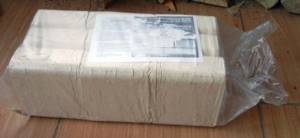
Lighting fuel briquettes is not very easy, the fire does not catch immediately, but after they light up, they will burn and smolder for a couple of hours, which is much longer than the combustion of ordinary firewood. Such a long combustion time of fuel briquettes is explained by their high density and low humidity.
The large amount of heat generated and the long burnout time indicate that the consumption of fuel briquettes for heating a house is much less than that required for ordinary firewood.
Let us note that, according to people’s reviews, you should not completely fill the firebox of a sauna stove with Euro-wood, so as not to quickly reach the maximum heat transfer values.
An interesting point with Eurobriquettes is the residues left after their combustion. Having increased density characteristics, this fuel burns almost completely; it does not leave a large amount of ash, only a small pile of ash. Ash from fuel blocks smells unpleasant, but is an excellent fertilizer.
When Eurobriquettes burn, virtually no smoke is emitted, which is very valuable for maintaining the cleanliness of fireboxes, boilers, and chimneys. According to experts, linden fuel briquettes contain the least amount of resin, so when using such fuel, chimneys and boiler nozzles suffer the least.
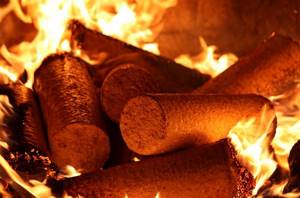
Fuel briquettes are an excellent option for lighting a black sauna. As we have already said, this fuel is environmentally friendly, does not emit smoke, provides enough heat, and phytoncides appear in the heated air, which have a beneficial effect on the human body and improve immunity. Using the same linden eurobriquettes, you will feel how your body is healing, inhaling the pleasant aromas of flowers, honey and trees.
Of course, there is also a drawback to this type of fuel - it cannot quickly generate a lot of heat, it releases it gradually. As we have already said, the combustion is uniform, which, unlike firewood that flares up quickly and quickly dies out, allows you to easily maintain the same temperature.
Is it possible to use briquettes instead of firewood and vice versa?
There are no fundamental differences, the whole difference is in density, because Euro-firewood is created using a press. Modern specimens do not have moisture, flare up quickly, and can emit flames for 4 hours.
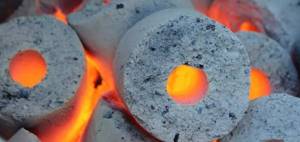
Pieces of logs cannot be called the most convenient, but they can also replace modern products if necessary; storing such large logs is very inconvenient.
Euro firewood does not have such unpleasant features as natural firewood, it does not spark, and during combustion it is impossible to notice a crackling sound followed by the emission of burning fragments.
The choice of what to heat the boiler with is entirely individual, but I am used to living with the times, so I confidently recommend a modern product, because the convenience of the heating process and the comfort of a private home will contribute to a beneficial break from everyday affairs.
House heating
Fuel briquettes are probably ideal for heating a home. The ability to light the stove once and maintain the fire and heat for a long time without additional tossing allows us to talk about the good characteristics of Eurobriquettes. Let's look at how to heat a brick stove with fuel briquettes within the house.
Of course, pressed bricks will not burn immediately, so let’s figure out how to light fuel briquettes. This is quite simple to do; first of all, you should put tree bark, wood chips, and some dry newspapers in the oven, and then place alternative firewood on top. During kindling, while the wood chips are actively igniting, we adjust the airflow. As soon as the fire starts on the first briquettes, you can add the rest.
Another option is to heat the stove with fuel briquettes after the first batch of wood has burned and decent coals have appeared. In such a firebox, the fire can quickly be caught on Eurobriquettes.

Depending on your needs, we choose the tactics for filling the stove with fuel:
- If you stack the fuel briquettes loosely, at a short distance from each other, the fire in the stove will be quite intense and will generate a lot of heat, which will allow you to quickly heat the house.
- If you stack alternative firewood tightly to each other and cover the vent, the firewood will smolder for a longer time, which is perfect for heating a house at night. At the same time, the consumption of fuel briquettes per day will be several times less than firewood.
In order to roughly understand how many eurobriquettes will be required to heat a house, you should conduct several experiments, each time finding out this parameter in practice. There are too many nuances in this matter.
It is worth noting that fuel briquettes have a specific purpose - to create heat, while firewood can be considered for the purpose of creating a comfortable and cozy environment. For example, is it possible to light a fireplace with fuel briquettes - well, of course, yes, but they will not create the same atmosphere as firewood with its pleasant crackling and uneven fire. By the way, the smell from burning wood is stronger and more pleasant.
In conclusion, I would like to say a little about the storage of Eurobriquettes and compare it with the preparation and storage of firewood. Fuel briquettes are sold in separate packages wrapped in cellophane. In this state, they are not afraid of moisture, which means they can be placed in a utility room, attic, basement or shed. Eurobriquettes look like bricks or tubes, all of the same shape, which is very convenient for storage. In addition, they take up much less space, since for the winter they will be needed several times less than firewood.
If we remember what difficulties await us when collecting firewood, there is food for thought when choosing the appropriate fuel. Eurobriquettes do not need to be sawed, split, stored and dried throughout the year; they are already ready for use.
How to load fuel briquettes into a stove
Before loading briquettes, it is advisable to clean the oven from ash and waste. But further installation will depend on:
- the purpose of kindling (you need to maintain heat for a long time or warm up the room quickly and strongly);
- features and design of your stove.
Important! It is precisely because of the strong differences in the technical characteristics of furnaces that it is impossible to give universal step-by-step instructions that will suit everyone. Therefore, we will describe only the basic installation schemes, amendments to which you can make yourself during operation.
Laying for ignition on top
If you want to put fuel in the stove so that it warms your home for several hours, then a good option would be to lay it on top for ignition.
- Place the briquettes tightly in the center of the firebox on top of each other in several layers.
- Make sure there is enough space between the briquettes and the walls of the firebox for air circulation. If the stove has weak draft, it is better to leave small gaps of 1-2 cm between the briquettes.
- Place kindling material on the top layer of briquettes. You can place an additional briquette surrounded by wood chips and paper, this will help heat up the oven faster.
- Light the fire and, as soon as the stove heats up, cover the vent.
Since the briquettes are homogeneous and emit almost no ash and waste, the rows will gradually burn out from top to bottom. Heating will last longer and the briquettes will not “fly down the chimney.” And given that, with the same volume as firewood, there is more fuel in briquettes, you won’t have to periodically add an additive to the stove.
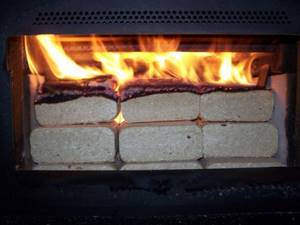
Laying for ignition from below
If you need to produce as much heat as possible, then a bottom-firing installation is suitable for you.
- Place kindling (wood chips, paper or newspapers with ignition impregnation) in the stove.
- Place briquettes around or on it in several layers, always with gaps between them for air circulation, otherwise it will be difficult to flare up.
- Set it on fire.
- As soon as the briquettes have flared up, close the ash pit (or close it completely so that the briquettes begin to smolder and not burn, and they will produce no less heat).
This approach will allow you to quickly and efficiently warm up the room, but fuel consumption will be higher.
By the way! As an alternative (not suitable for all stoves), you can immediately arrange the briquettes in dense rows and light the central ones until they begin to smolder. After this, close the ash pit, the briquettes will begin to generate heat without open fire. This way the briquettes will last longer.
